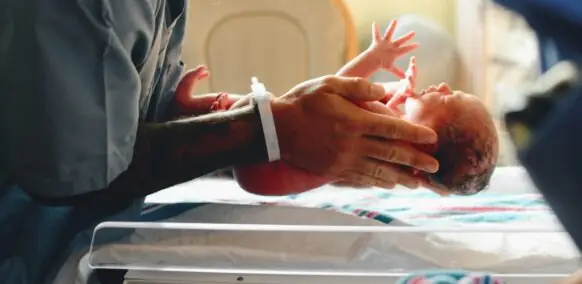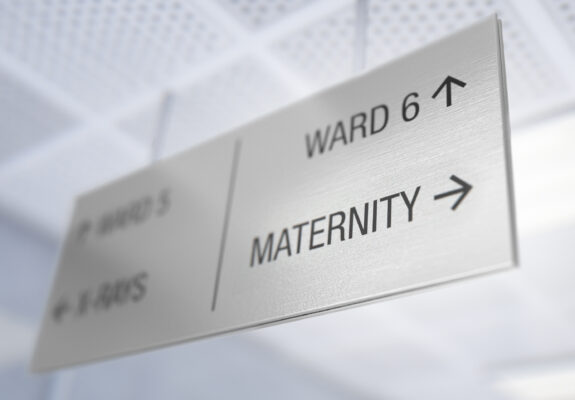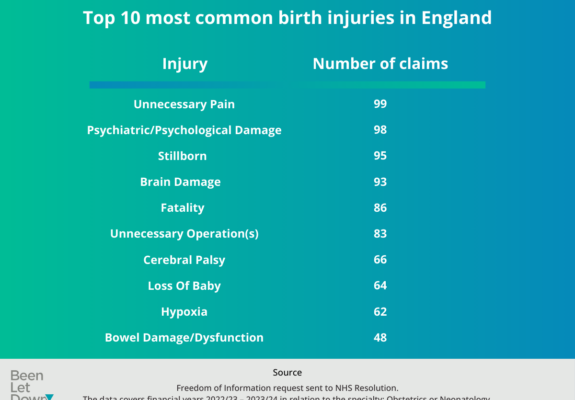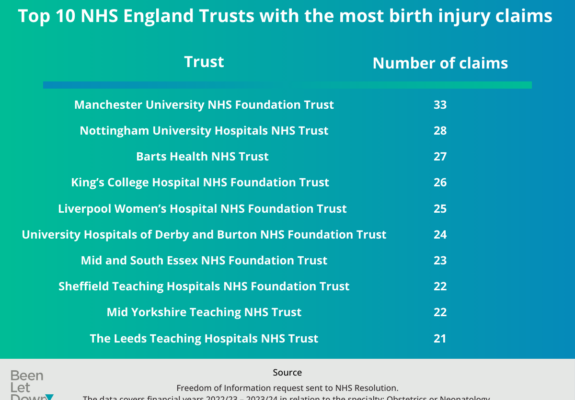NHS England Birth Injuries Report 2025
We examine birth injuries using the latest claims data and maternity survey statistics, uncovering the most common types of birth injuries and their causes.


The birth of a baby should be a time of celebration for the whole family. However, if a birth injury occurs because of mistakes made by nurses, doctors or midwives, there can be serious consequences for the mother and her newborn child.
In the worst cases, medical negligence can lead to life altering conditions related to brain damage, or even the loss of a baby.
Our concern is that poor maternity care is being normalised and incidents of serious harm are going underreported.
A worrying number of birth injury claims have been traced back to failed or delayed treatment, including the failure to respond to ‘red flags’ (such as an abnormally fast heartrate, low fetal heart rate, bleeding, reduced fetal movements, failure to progress in labour, gestational diabetes) and a failure to recognise arising complications.
Additionally, the latest CQC Maternity Survey (2023) revealed that one in five (20%) patients reported they didn’t feel their concerns were taken seriously during birth. That’s why we’ve commissioned this new Birth Injuries Report to reveal the impact of inadequate maternity care in England.
In this report, we have analysed in-depth data sourced through a Freedom of Information request to NHS Resolution, alongside literature and reports on maternity care across the country.
How common are complications related to birth injuries?
First of all, it’s important to note that the NHS remains one of the safest healthcare systems in the world in which to give birth.
NHS Resolution’s dedicated Early Notification Scheme also provides a dedicated service to investigate brain injuries at birth, determining whether negligence has caused harm.
According to our research, there were 1,503 claims made to NHS England Trusts, where the speciality was ‘Obstetrics of Neonatology’ (maternity) between 2022 and 2024.
In contrast, there were approximately 1.125 million babies born in the UK in the same timeframe. As such, approximately 0.13% of births resulted in a potential claim, which means these are fortunately very rare.
It’s also worth noting there can be delays in the claims being put in, and some births involve claims in more than one area, so this isn’t a complete, comparative figure.

According to the data we sourced from NHS Resolution, the single most common birth complication between 2022-2024 was ‘unnecessary pain’ to the mother or baby.
‘Perineal laceration/tear during delivery’ is the most common complication to occur during labour, which is a tear in the tissue (skin and muscle) around the vagina. This is not referenced in the list of the primary injuries associated with maternity claims, although it is an injury that could be connected to ‘unnecessary pain’ claims, in some instances where there has been a failure to perform a cut called an episiotomy, or where the tear or cut has been negligently and incorrectly sutured.
Psychiatric/psychological damage was the second most common complaint, followed by stillborn births and brain damage.
A very serious injury, which can occur due to failures in care, with life-long consequences is cerebral palsy. This is a group of lifelong conditions that affect movement and co-ordination. Cerebral palsy can happen if a baby’s brain does not develop normally while they’re in the womb, or is damaged during or soon after birth (Cerebral palsy – NHS). There have been 66 claims made in relation to this in the last two years alone.
It’s worth noting that any of these birth injuries could relate to incidents that occurred years before the claims were settled, as it can take time for families and the NHS resolution to reach an agreement.

Data showing the primary cause for a birth injury claim, as opposed to the primary injury, sheds more light on the concerns of patients and the potential shortcomings of the health service.
By far the most common cause for complaint was the ‘failure or delay to treatment’, which was referenced in 73 maternity claims made to NHS Trusts between 2022-2024
This was followed by ‘failure to recognise complications’ (11 claims) and ‘failure to respond to abnormally fast heart rate’ (10 claims).
All these causes of birth injuries are generally considered avoidable in most instances.

Breaking the data down regionally, we have identified which NHS Trusts are seeing the highest volumes of potentially preventable birth injuries.
However, it’s worth mentioning that the data on NHS Trusts should not be interpreted as a league table, as the larger organisations and those that provide more complex treatments may receive more claims than the smaller organisations or those providing low risk care.
Overall, Manchester University NHS Foundation Trust received the most claims between 2022-2024, at 33.
Manchester was followed by Nottingham University Hospitals NHS Trust (28) and Barts Health NHS Trust in London (27).
It’s worth noting that when reviewed by the CQC in 2023, most of these Trusts were performing around ‘national average’ levels based on patient feedback.
This survey looked at the experiences of women and other pregnant people who had a live birth.
While at a national level, people’s experiences of care have deteriorated (overall) in the last five years, the latest results relative to 2022 showed signs of improvements in many specific Trusts.
Between 2023 and 2022, 38 Trusts showed significant improvement, across all areas of antenatal care.
However, the regional breakdown shows that Mid and South Essex Foundation Trust received a lower patient rating (out of 10) for effective pain management during birth / labour (6.6/10, versus a national average of 7.5).
Barts Health and Bolton NHS Trusts also received lower-than-average patient scores in three specific areas (effective pain management, concerns taken seriously, trust in staff) during labour.
Meanwhile, Leeds Teaching Hospitals NHS Trust received a higher patient rating for pain management during labour (8.2/10, versus a national average of 7.5).
Leeds also received higher than average scores from patients for ‘concerns taken seriously during labour’ (8.8/10, versus a national average of 8.1) and ‘trust and confidence in maternity staff’ (9.1/10, versus a national average of 8.7).
Imperial College Health NHS Trust in London also received above average patient ratings in these three areas.
In general, claims data is only reflective of a minority experience, and should therefore not be a direct cause for concern amongst pregnant people who are looking to select a hospital for their prenatal, birth, and antenatal care.
What is behind the alarming rate of birth injury compensation claims?
The number of births in the UK has been slightly declining – it was down 19% in 2022 versus in 2012 (547,000 versus 671,000).
While the number of births is down, generally speaking the number of midwives has risen. There were 317,000 midwives in 2022, versus 300,000 in 2012.
More midwives are still being sought though – there were 37,000 nursing vacancies (including midwives) in 2023, which represented 9% of all NHS vacancies.
These numbers are moving in the right direction but pressure points within the NHS could be leading to mistakes being made, which are resulting in serious injuries being caused to the mother or the baby, in a very small number of instances.
Alongside life changing injuries such as brain damage and cerebral palsy, poor pain management is also cited as a key development area to minimise the risk and impact of a labour to the mother (and in turn avoid unnecessary distress being caused to the baby).
Pain management in particular appears to be an area where further work is required.
What do other experts think?
A recent report from the Care Quality Commission warned that “poor care within maternity is being normalised” and the failures identified in high-profile scandals are “widespread” rather than “isolated”.
The review examined 131 maternity unit inspections carried out between August 2022 and December 2023.
Nearly half the units that were inspected were found to be “inadequate” or “require improvement” overall. Nearly half (48%) were also found to “require improvement” for safety.
An article from iNews, published in September 2024 also highlighted how some NHS maternity services are still “promoting normality” in childbirth too (vaginal birth without medical interventions, including pain management).
In the 2023 CQC Maternity survey, one in ten (13%) patients said they didn’t think healthcare professionals did everything they could to help manage their pain during labour and birth.
In the same survey, one in twenty maternity patients (5%) reported that they weren’t able to get a member of staff to help when they needed it (again during labour and birth). And this rose to 10% of patients, after birth.
One in five (20%) also reported that they didn’t feel their concerns were taken seriously during birth, while 12% stated that the nurses and doctors involved in the labour or birth were unaware of their medical history.
Our conclusion
Carla Duprey, Solicitor in the Clinical Negligence Department at Been Let Down, said: “As previously highlighted in our blog relating to the recommendations that have been made by the CQC to specific NHS Trusts in recent years, it takes time for these to be implemented before they can start making an impact on the safety and quality of care being provided to patients.
“It appears to me that a lot of the issues are core problems within the NHS and are not able to be rectified easily. Funding and staff recruitment are major issues.
“However, as many Clinical Negligence Practitioners have pointed out in the past, if the NHS developed a system to report and learn from incidents and claims on a regular basis, then I believe this would be a first step to improving the overall service.
“Our participation in the Southport Inquiry and the Thirlwall Inquiry reflects our dedication to addressing complex issues in clinical and professional negligence and our commitment to achieving fair outcomes.
“We see this as an opportunity to contribute to meaningful change and ensure accountability where it matters most.
“Having successfully concluded high profile class actions in the past, we are pleased to be able to offer victims our services and support in these new cases and we are committed to fighting for justice for them.
“If you’re thinking of pursuing a birth injury negligence claim, you can rest assured that we’ll be with you every step of the way.
“Our team aims to achieve the best possible outcome for both you and your child to cover the costs of rehabilitation, care, and any home adaptation required after birth injury.”
Call us on 0800 234 3234 or contact us online and a member of our legal team will call you back.

Freedom of Information request sent to NHS Resolution for data on the following:
- The number of Clinical Claims and Incidents received where the Specialty is ‘Obstetrics’ or ‘Neonatology’ split by Trust and primary injury
- The number and cost of Clinical Claims Closed (or settled) with damages paid, where the Specialty is ‘Obstetrics’ or ‘Neonatology’ split by Trust (with 5 or more claims), primary injury and primary cause
The data covers financial years 2022/23 – 2023/24 in relation to the specialty: Obstetrics or Neonatology.
Further insight and information was also sourced from the following articles and reports to inform our own report:
- NHS Maternity Data Dashboard – https://app.powerbi.com/view?r=eyJrIjoiOTg1YTkzNWQtNTM1NS00YmE0LWEzNTktMWQ3ZTRlNWM5ZmUyIiwidCI6IjM3YzM1NGIyLTg1YjAtNDdmNS1iMjIyLTA3YjQ4ZDc3NGVlMyJ9
- https://digital.nhs.uk/data-and-information/publications/statistical/maternity-services-monthly-statistics
- https://digital.nhs.uk/data-and-information/publications/statistical/nhs-workforce-statistics
- https://www.hsj.co.uk/patient-safety/patient-safety-watch-the-worrying-normal-of-maternity-care/7037841.article